Altai onion Alves: description and cultivation features
Is your garden plot any different from others? Do you want to grow something new, moderately exotic and at the same time unpretentious? Alves is an unusual type of onion that will not only transform your summer cottage, but also make your menu more useful. Alves has a rich vitamin composition and piquant taste that perfectly complements the usual dishes of the dish. What else is good about the variety - find out in this article.
The content of the article
Description of the Altai onion variety Alves
Consider the origin of the variety, composition and useful properties, appearance, advantages of Altai onions over other varieties.
Origin and development
Wild batun, Siberian wild onions, Mongolian onions, stone onions - all this is about Altai onions... It got its name due to its wide distribution in the Altai Territory. However, the mountainous regions of China, Mongolia, Kazakhstan, Buryatia are considered to be its homeland.
Alves, one of two varieties of Altai onion, grows on scree, rocky outcrops that are high above the sea.
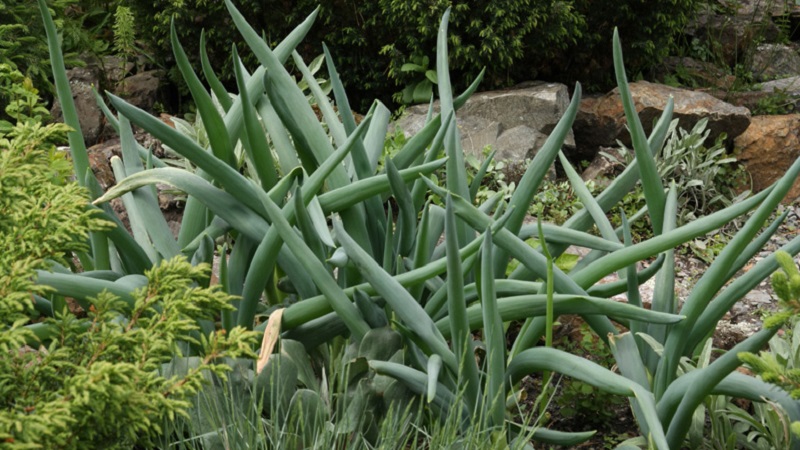
Chemical composition, trace elements, vitamins and beneficial properties
Alves contains a lot of useful substances, including:
- vitamin A, necessary for the full formation of the tissues of teeth and bones, as well as the structure of cells;
- vitamin B1, which plays an important role in the functioning of human organs and systems;
- vitamin B2 is responsible for the healthy condition of the skin, nails and hair;
- vitamin C performs important recovery functions and is an important cofactor in many body processes;
- phytoncides that protect a person from diseases, increase performance;
- carotene has a huge effect on immunity, heart and vision, and is also responsible for the correct functioning of the reproductive system;
- useful micro- and macroelements, including potassium, calcium, sulfur, phosphorus, chlorine, magnesium, sodium, iron.
Altai bow has a complex beneficial effect on the body:
- stimulates appetite, gastrointestinal processes and improves bowel function;
- has a sedative effect on the central nervous system;
- normalizes sleep and blood formation;
- removes excess water from the body;
- strengthens the immune system;
- improves the condition of blood vessels and the cardiovascular system.
However, if you have gastritis, ulcers, urolithiasis, eating Alves onions is not recommended.
There are only 19 kcal per 100 g of product, as well as 1.72 g of proteins, 0.23 g of fat, 9.57 g of carbohydrates, in a ratio of 14.9% protein, 2% fat and 83.1% carbohydrates.
Interesting on the site:
Application features
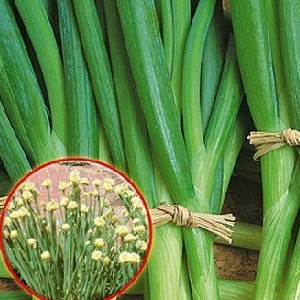 Alves has a semi-sharp taste, its greens are usually added to soups, salads, omelets, meat dishes, it perfectly complements them.
Alves has a semi-sharp taste, its greens are usually added to soups, salads, omelets, meat dishes, it perfectly complements them.
It is recommended to use herbs while they are still freshhowever, it is also suitable for long-term storage. For this, the onion is dried or frozen.
As Altai onion gives beautiful white flowers with a yellow tint, it is used as a decorative element in summer cottages, as well as when creating rocky gardens.
Ripening period
Alves belongs to the rapidly maturing plants, its growing season is 25-30 days.
Yield
The variety has a high yield - from 1 sq. m are harvested from 2 to 4 kg, the bulb weighs about 40 g.
Disease resistance
Altai onions have immunity to diseases and pests... So, Alves successfully resists powdery mildew, rust and bacteriosis, but the culture can suffer from peronosporosis.
Characteristics of the bulb, description of the appearance, taste
Altai onions are often compared to batun onions, because both plants are powerful and highly branched. The color of the leaves of Alves is bluish-green, and the leaves are shorter, but wider in length. The succulent leaves exude a pleasant taste, especially when grown during wet and cool summers.
The root system is developed... Alves bulbs are 1.5-5 cm in size, oblong-ovoid, attached to the oblique rhizome, located 10-15 cm deep. This arrangement allows the bulbs to withstand even the harshest conditions.
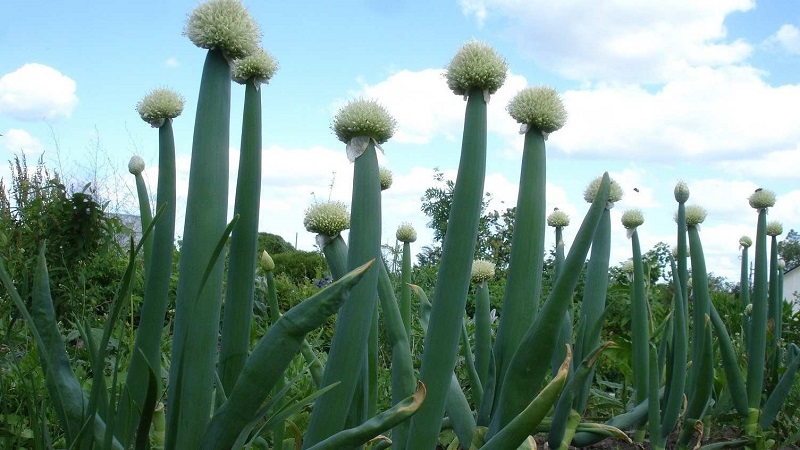
One bulb is characterized by the presence of four feathers up to 30 cm long... These feathers are fistulous, have a sharp end and are covered with a bloom of a bluish tint. In the middle there is a fist-shaped peduncle up to 70 cm high. A bud opens on it, from which light yellow flowers later appear. Alves bloom can be observed up to three weeks, in this regard, the variety is often used as a decoration for a garden plot.
Important! Alves is a melliferous plant that produces thick yellow honey from its flowers.
For which regions it is best suited and what is the exacting climate
The habitual distribution area of the Altai onion - Siberia, however, Alves can be grown in central Russia.
Alves is patient with darkening and partial shade, accustomed to frost and cold... In addition to the Altai territory, it grows on the lands of Buryatia and in the north of China, where a predominantly harsh climate reigns. So neither spring frosts, nor sub-zero temperatures down to -10 ° С are terrible for the variety.
The main advantages and disadvantages of the variety
Despite the fact that Alves is difficult to distinguish from a batun onion, it has a number of features:
- a large number of bulbs - about 25 per bush;
- powerful branched root system;
- fisty tall stem, when bleached, it gets a delicate taste;
- dense globular umbrellas of white-yellow flowers;
- rich nutritional value - carotene and vitamin C are much more than in onions.
Features of planting and growing
Knowing the peculiarities of planting and growing, you have an excellent chance to grow a healthy harvest of Altai onions.
Preparing for landing
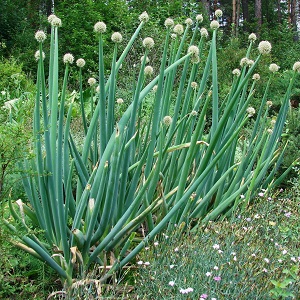 Despite the fact that Alves can grow on different lands, he will not like too dark places and acidic soil... Before sowing, it is recommended to loosen the beds with a hoe, and then dig up the soil and fertilize it with 50 g of diammofoska and 5 kg of humus.
Despite the fact that Alves can grow on different lands, he will not like too dark places and acidic soil... Before sowing, it is recommended to loosen the beds with a hoe, and then dig up the soil and fertilize it with 50 g of diammofoska and 5 kg of humus.
We prepare the seeds for sowing by filling them with a solution of potassium permanganate for 12 hours... Then we soak them for an hour in aloe juice. This way they will sprout faster.
After soaking, the seeds are driedto make it easier to plant.
Ground requirements
It is recommended to choose a bright area with non-acidic soil, but if there is none, then it is desirable to lime it. For this we use wood ash 1.5 kg per 1 sq. m.
Predecessors
Competent crop rotation is a guarantee of high yields... Thus, cucumbers, tomatoes and legumes are considered the best predecessors of Alves.
It is not recommended to plant the variety in a place where it was previously grown pumpkin seeds, cereals and cabbage.
Read also:
Timing, scheme and landing rules
The best season for planting Alves by seeds - from early April to November.
Seeding Algorithm:
- dig holes 2 cm deep and 5 cm long;
- the distance between the recesses is about 5 cm, between the beds - 30 cm;
- water the beds;
- pour 3-4 seeds into each hole;
- sprinkle the seeds with soil and water.
Growing features
Dig up the soil before sowing 15 cm deep and remove all weeds. After that, add 5 kg of nitrophosphate per 1 sq. m.
For best results, sow strictly according to the rulesdescribed above.
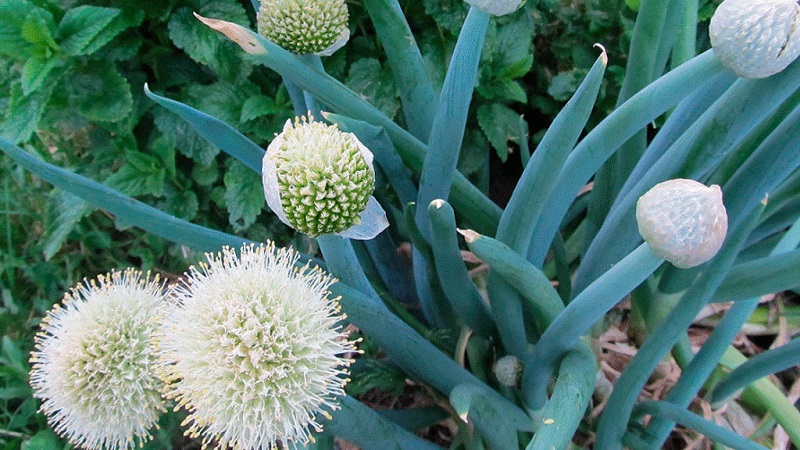
The nuances of care
Caring for Alves is almost no different from caring for onions... He also needs timely watering, top dressing, loosening the soil, weeding.
Important! To obtain large bulbs, Alves peduncles are removed.
Watering mode
The variety is drought tolerant, so water it as needed.
The optimal amount of watering - 1-2 times a week, as excessive moisture and stagnant water in the soil will only harm Alves. Watering is recommended with warm, settled water.
Loosening the soil and weeding
Growing onions need care that includes loosening the soil and weeding.
Loosening is carried out after each cut of feathers, after watering or rain... Don't overdo it with weeding - do it as needed.
Top dressing
During the growing season, the plant is fed about five times... In March, dilute 1 tbsp in a bucket. l. ammonium nitrate, and after each of the four trimming of feathers - 1.5 liters of mullein and 100 ml of ash per 10 liters of water.
Important! Be careful with the amount of fertilizer, as overfeeding can lead to disruption of plant development.
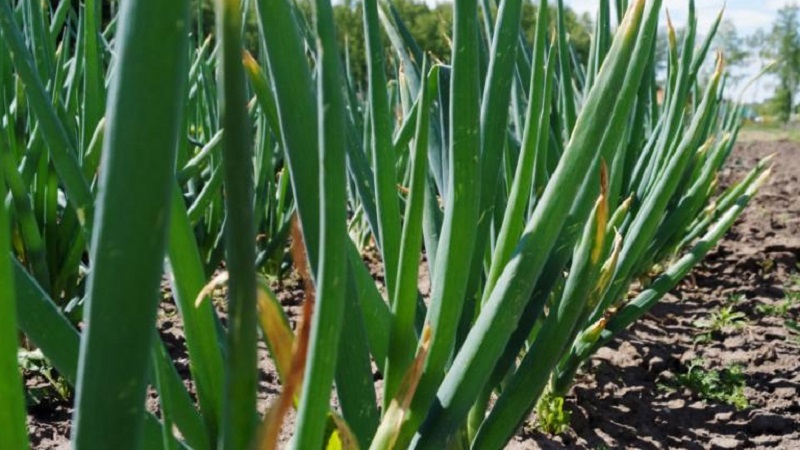
Disease and pest control
In general, Alves is resistant to pests and diseases, its only weakness is peronosporosis... For the prevention of disease, onions are fed with phosphorus-potassium fertilizers in the amount of 15-20 g per sq. m. If the disease has already attacked the plant, milk whey is used to combat it. It is simple to make it: water is added to curdled milk or sour milk in a ratio of 1:10.
Harvesting and storage
It is important to know the timing of the harvest, as well as the storage conditions.so that the vegetable delights with taste for a long time.
How and when to collect
The plant ripens quickly: leaves appear within a month after sowing. During ripening, about 2-4 trimming of feathers is carried out. Cutting height of leaves - 5 cm from the ground.
Storage features and keeping quality of the variety
Culture bulbs are distinguished by good keeping quality. It is recommended to store onions in a well-ventilated area at room temperature.... Greens are dried or frozen.
What can be the difficulties in growing
When the basic rules of care are followed, gardeners do not have any difficulties... The culture is characterized by drought resistance, cold resistance, minimum requirements for lighting conditions.
Be careful with nitrogen fertilizers in spring, with an excess of them, the plant becomes lethargic and prone to disease, and the bulbs become loose. Accordingly, the shelf life is reduced.
Tips from experienced gardeners
The recommendations of experienced farmers will facilitate the process of growing Altai onions:
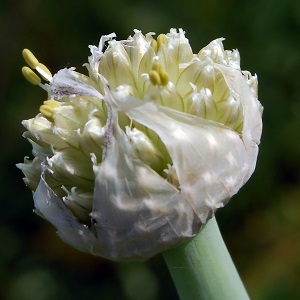 If you want to delight yourself with the harvest in winter, plant Alves on the windowsill. Experienced gardeners advise in advance (in the fall) to prepare material for planting along with a lump of earth and install it in a box. Store seedlings at 2-4 ° C.
If you want to delight yourself with the harvest in winter, plant Alves on the windowsill. Experienced gardeners advise in advance (in the fall) to prepare material for planting along with a lump of earth and install it in a box. Store seedlings at 2-4 ° C.- It is not recommended to grow Alves onions in the same place for five years.
- Experienced farmers advise feeding the Altai onion with phosphorus-potassium fertilizer to accelerate ripening and increase keeping quality.
Reviews of the Altai onion variety Alves
The variety has established itself among summer residents who speak positively about Altai onions.
Albina, Asha: “Alves has a delicate feather. We collect the first feathers in July and all summer we have juicy onion greens.Although the onion grows for the first year, it already produces good feathers that are suitable for vinaigrettes and other salads. It grows very quickly after trimming ".
Irina, Tyumen: “Altai onion can withstand absolutely any frost in winter. At least -40 ° C. Moreover, its young leaves easily tolerate spring frosts down to –10 ° С! And the first green is shown directly from under the snow. Taste - with a light piquant bitterness. "
Conclusion
Alves is an unpretentious onion variety that does not require constant watering and grows steadily even in the harshest conditions of Siberia and central Russia. Produces a rich and tasty harvest of bulbs and herbs that go well with any dish. In addition, flowering onions are used as a picturesque decoration for a garden plot.